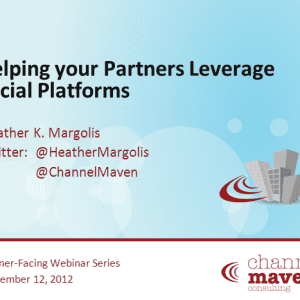Topics
Channel Trenches: If You Build It, Will They Come? The Trials Of Building An Indirect Sales Channel
 By Tony Serino, Founder, Serino Channel Services
By Tony Serino, Founder, Serino Channel Services
An ISV focused on product development solutions (Computer Aided Engineering (CAE)/Lifecycle Management) needed to drive top-line sales with and through its channel of technical resellers and IT service companies to meet its dramatically increased sales budget. The organization had a small window of opportunity to motivate, mobilize and measure its indirect sales channel and their joint effort to develop and capture more leads, sales, and market share.
But first the ISV needed to build deeper relationships with and within its partner network. After polling its partners to gain a first-hand understanding of their needs, it was learned that the following matters were very important to “most of the partners.”
The partners insisted on:
- Co-branding their businesses, focus, and skills with their “vendor partner” application/solution;
- Minimal disruption to their day-to-day operations and sales efforts;
- Training/Education for themselves and the ability to extend the appropriate information and materials to their clients;
- Final say on target market focus; and
- Ability to objectively assess any joint lead generation efforts both as a whole and “in many parts.”
By implementing the Content Syndication/Partner Marketing solution on Marketing Advocate’s SaaS platform, the ISV was able to define, prioritize, stage, and deliver content to the precise target audiences while simplifying, expanding, and measuring its joint lead generation efforts with select channel partners.
Simplifying The Buyer’s Journey From Prospect To Client
Initially, the ISV provided approximately 100 pieces of its sales collateral to Marketing Advocate as electronic files. These documents were entered into a sandbox web site using taxonomy of the current end-user pain points and other common topics typical prospect/customers use to seek out information, such as “product” and “industry” categories.
The web site and the partners’ efforts were aligned to a scheduled calendar of topical messages and then automatically delivered in the name of the partner via email and social media marketing platforms.
Marketing Advocate also built other navigation capabilities into the sandbox web site, making it simple for their partners to see how web visitors would view and access the sales collateral categorically, in the following ways:
- Business need;
- Technology (products, services, solutions);
- Financial/TCO/ROI matters;
- Industry-specific issues; and
- “Other.”
Winning Partner Buy-In
After the sandbox web site was available the ISV presented the concept and details of the proposed joint-promotional efforts to its partners to gain their buy-in. During a web meeting, the company’s channel manager and a Marketing Advocate executive presented a cohesive plan-to-action, which included the following steps and assets:
1. The concept and detailed plan for a joint effort, which included both the ISV’s and the partner’s expectations and program requirements such as financial contribution, commitment of resources, lead follow-up and marketing skill sets.
2. The web site sandbox, featuring:
– Its visitor capture, scoring and communication capabilities;
– Content about the industry;
– Content about the ISV and its solution; and
– Faux copy about a fictitious partner, emphasizing the partner’s skills and that “the fictitious partner” would easily become “the partner in the web meeting.”
This matter is of profound importance and consequence for at least two reasons: The reseller can feature their skills, experience, and resources as they relate to helping the prospect use technology to address and resolve their needs. The needs and resolution of those needs, of the prospect/buyer were given higher priority and visibility than the product. The partner also was positioned and depicted as an expert in addressing and resolving the issues the prospect/customer typically face. This resulted in the prospect/buyer being presented information and materials such that the information and materials addressed their issues, and were not presented in the manner of “what products they are trying to sell me.”
3. A calendar of email topics was tightly aligned with the ISV corporate promotional efforts and time lines.
4. A go-to promotional strategy for each partner was discussed. The ISV stressed that each partner would have their own customized site with promotional copy about their organization, as well as the partner logo and all calls-to-action.
Upon acceptance (buy-in), the partner would become part of the ISV’s lead generation/ lead nurturing system, which included:
- A series of ISV-supplied, partner-customized emails, sent every three weeks to 5,000 or more contacts. The partner defined contact demographics and both Marketing Advocate and the partners provided records;
- Automatic nurturing based on web visitor actions. The system automatically “pushed” relevant content to the visitor continually as it became available and until the recipient “opted out;
- Telemarketing services to gain Budget, Authority, Need and Timing (BANT) information; and
- Communication about a lead either daily or weekly, depending upon the sense of urgency tied to the lead score assigned by the system or a telemarketing representative.
Web visits were captured, scored, and communicated in real time or batch based on the assigned score tied to behaviors, including: When someone visited; who visited; what they accessed on the site; and how long they were on the site.
Data about each email sent also was captured, measured and communicated with the partner, including the number of emails sent, opened, clicked-through and bounced (soft and hard).
Customization, Launch And Results
Marketing Advocate customized the sandbox (one word or two?) web site and emails by collecting information about the partner through a combination of web forms, phone calls, and web meetings. This customization process flowed systemically into the Marketing Advocate web and email templates, thus transforming the sandbox template into a highly customized web site, unique to each partner, including content about the partner “as it related to about 50 ISV proof points”, links to specific people as defined by the partners, and creative assets to ensure the web site matched the partner corporate web site and visual image. Each partner then viewed and authorized their site to go live, either “as is” or “with changes.” The same authorization process was implemented for the entire email series.
Preparation for the six-month campaign, including the customized web site and email series, was completed in less than 60 minutes by leveraging the ISVs existing content and campaigns. After set-up, it took each partner “about 20 minutes per month” to sustain the effort, including granting their approval of each new email creative before the next email is sent.
To ensure that partners’ sales team was aware, capable, and motivated, a “Sales Readiness Site” was built for the partners’ sales reps. This site functions as an “electronic cheat sheet” allowing the sales rep to study/research the topic prior to making a sales call on a lead, using the ISV’s content and internal/partner-use-only materials about customer pain points and competitors’ weaknesses.
The sales site, along with the expectations of each person at each company was used along with the now-customized web site as the framework for partners’ internal sales kick-off meeting and subsequent sales review meetings with the ISV and its partners.
The Marketing Advocate system distributed email campaigns every three weeks, automatically communicated with partners, and nurturing visitors’ interests based on their behaviors and other key performance indicators.
A snapshot of the results from the first email campaign for one partner includes:
- More than 200 unique responses and 6 hot sales opportunities;
- $500,000 forecasted in services and licensing revenue (based on a conservative 15% conversion rate);
- 90:1 forecasted pipeline-to-ROI ratio; and
- 5 closed deals.
Tony Serino of Serino Channel Services (www.ChannelsMarketing.com) is a leading channel development expert with very deep, first-hand expertise in maximizing sales / profits for technology vendors and channel businesses working in partnership. Tony experience working at, for, and with channel companies and IT vendors centered on identifying, engaging, and managing partnering relationships to generate new business opportunities and measure the impact “for all parties involved.”














